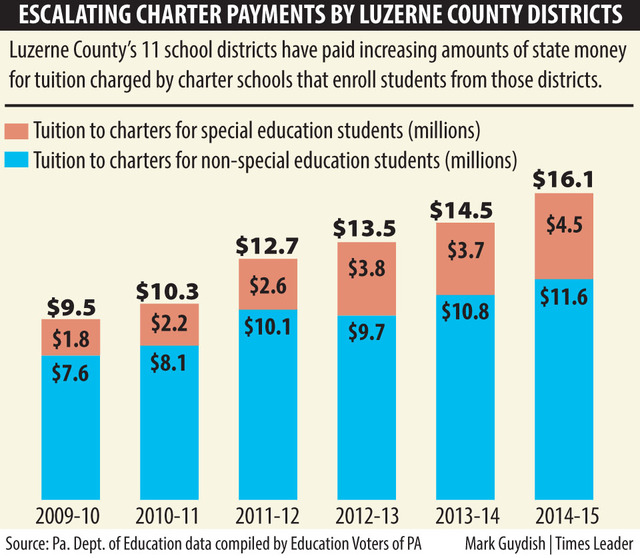Charter schools, particularly online “cyber charters” have increasingly been blamed for school district financial woes, with administrators contending charters siphon much-needed money from district coffers.
An advocacy group recently compiled state data for all 500 districts in the state showing just how much money is involved, providing payments to charters during a six-year span.
The local hit is steep: Luzerne County’s 11 school districts paid $16.1 million for charter school tuition in 2014-15. It’s also escalating rapidly. The data shows the payments by all 11 districts increased 70 percent since 2009-10.
Charter schools are public schools free of many state regulations. The initial idea was to let a school board grant a charter to a new school that could try different ideas in the classroom, with districts and charters collaborating to improve education for all students.
Charters are financed by a per-student tuition paid from the district where the student ordinarily would attend school. The theory is simple: The money the district would have spent on a student goes with the student to the charter school.
But the relationship became adversarial quickly. Districts often rejected requests for charters, forcing those who hoped to establish one to appeal to the state. That is how Luzerne County’s lone brick-and-mortar charter school — Bear Creek Community Charter — came to be after repeated rejections by the Wilkes-Barre Area School Board.
But charters expanded without physical buildings, thanks to cyber charters, where students do the bulk of school work online. As cyber charter enrollment increased, so did complaints from local school boards. It has become an almost annual lament: budgets are tight because the district loses money by forking it over to charters.
Northwest Area School District officials cited money lost to charters as a major drain when the school board started working in January on the 2017-18 budget. School districts point out that losing students to charter schools rarely translates into savings equal to the per-pupil payment to those charters.
Pennsylvania Auditor General Eugene DePasquale has repeatedly questioned charter payments, contending charter schools get far more than they spend per student. Charter proponents deny accusations by critics.
So how much have local districts been paying to charter schools? A group called Education Voters of PA compiled state data into an online spreadsheet, letting anyone with Internet access look up the district of their choice.
The data shows that, in 2009-10, Luzerne County districts collectively shelled out $9.5 million in charter tuition, $7.63 million for regular education students and $1.85 million for special education students. The amount rose every year, hitting $16.1 million in 2014-15, the latest data available in the spreadsheet.
The data also shows that, percentage-wise, charter payments for special education have exploded, climbing to $4.5 million, an increase of 142 percent. By comparison, regular education payments rose 53 percent, to $11.6 million.
Greater Nanticoke Area saw the biggest increase by percentage, though it started out paying much less for charter tuition than any other district in the county: $96,065 in 2009-10. That skyrocketed to $868,225 in 2014-15, an increase of nearly 804 percent.
Wilkes-Barre Area paid far more than any other district in each of the six years, shelling out nearly $4.3 million in 2009-10 when only two other districts — Wyoming Valley West and Hazleton Area, topped $1 million. In 2014-15, Wilkes-Barre Area paid nearly $6.7 million in charter tuition, a 55 percent increase, while Hazleton Area was a distant second at $2.1 million.




